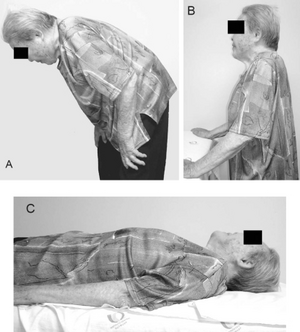Camptocormia: Difference between revisions
No edit summary |
No edit summary |
||
| Line 1: | Line 1: | ||
{{Stub}} | {{Stub}} | ||
[[File:Camptocormia.png|thumb|right|A patient with camptocormia]] | [[File:Camptocormia.png|thumb|right|A patient with camptocormia]] | ||
'''Camptocormia''' is characterised by marked flexion (greater than 45 degrees) of the thoracolumbar spine that increases during the day | '''Camptocormia''' also known as '''bent spine syndrome''' is a usually organic disorder characterised by marked flexion (greater than 45 degrees) of the thoracolumbar spine that increases during the day and completely disappears when supine. | ||
== | ==Terminology== | ||
The term comes from the Greek words "to bend" (kamptō) and "trunk" ("trunk"). | |||
==Aetiology== | ==Aetiology== | ||
Camptocormia can have a neurological or muscular origin | Camptocormia can have a neurological or muscular origin. There are a multitude of causes. | ||
*Parkinson's disease: the most common cause (two third). | *Parkinson's disease: the most common cause (two third). | ||
*Other parkinsonian syndromes | *Other parkinsonian syndromes | ||
*Multisystem atrophy | |||
*Alzheimer's disease | |||
*Motor neuron disease | |||
*Myaesthenia | |||
*[[Chronic Inflammatory Demyelinating Polyneuropathy|Chronic inflammatory demyelinating polyneuropathy]] | |||
*Dystonia | *Dystonia | ||
*Vascular lenticular lesions | *Vascular lenticular lesions | ||
* | *Primary or secondary myopathy | ||
* | *[[Internal Disc Disruption|Lumbar disc herniation]] | ||
*[[Osteoarthritis]] | |||
*Spinal trauma | |||
*Paraneoplasia | |||
*Medication side effects (olanzapine, donepezil, valproate, systemic steroids) | |||
==Epidemiology== | ==Epidemiology== | ||
| Line 20: | Line 29: | ||
==Clinical Features== | ==Clinical Features== | ||
As the day goes on or during walking there is a progressive marked flexion of the thoracolumbar spine. It is relieved by sitting and lying supine. It can also be relieved volitionally by extending the trunk when the patient leans against a wall. There may be associated lateral deviation of the trunk. In two thirds of patients there is a lumbar or thoracolumbar scoliosis.<ref name=":0" /> | As the day goes on or during walking there is a progressive marked flexion of the thoracolumbar spine. It is relieved by sitting and lying supine. It can also be relieved volitionally by extending the trunk when the patient leans against a wall. There may be associated lateral deviation of the trunk. In two thirds of patients there is a lumbar or thoracolumbar scoliosis.<ref name=":0" /> | ||
== Treatment == | |||
Treatment is usually unrewarding. Where possible treatment should be directed to the underlying cause. | |||
==Further Reading== | ==Further Reading== | ||
Revision as of 16:05, 26 March 2022
Camptocormia also known as bent spine syndrome is a usually organic disorder characterised by marked flexion (greater than 45 degrees) of the thoracolumbar spine that increases during the day and completely disappears when supine.
Terminology
The term comes from the Greek words "to bend" (kamptō) and "trunk" ("trunk").
Aetiology
Camptocormia can have a neurological or muscular origin. There are a multitude of causes.
- Parkinson's disease: the most common cause (two third).
- Other parkinsonian syndromes
- Multisystem atrophy
- Alzheimer's disease
- Motor neuron disease
- Myaesthenia
- Chronic inflammatory demyelinating polyneuropathy
- Dystonia
- Vascular lenticular lesions
- Primary or secondary myopathy
- Lumbar disc herniation
- Osteoarthritis
- Spinal trauma
- Paraneoplasia
- Medication side effects (olanzapine, donepezil, valproate, systemic steroids)
Epidemiology
In those with Parkinson's disease and camptocormia there is a male predominance, older age, longer duration of disease, and autonomic symptoms.[1]
Clinical Features
As the day goes on or during walking there is a progressive marked flexion of the thoracolumbar spine. It is relieved by sitting and lying supine. It can also be relieved volitionally by extending the trunk when the patient leans against a wall. There may be associated lateral deviation of the trunk. In two thirds of patients there is a lumbar or thoracolumbar scoliosis.[1]
Treatment
Treatment is usually unrewarding. Where possible treatment should be directed to the underlying cause.
Further Reading
References
- ↑ 1.0 1.1 Benatru, I.; Vaugoyeau, M.; Azulay, J.-P. (2008-12). "Postural disorders in Parkinson's disease". Neurophysiologie Clinique = Clinical Neurophysiology. 38 (6): 459–465. doi:10.1016/j.neucli.2008.07.006. ISSN 0987-7053. PMID 19026965. Check date values in:
|date=(help)
Literature Review
- Reviews from the last 7 years: review articles, free review articles, systematic reviews, meta-analyses, NCBI Bookshelf
- Articles from all years: PubMed search, Google Scholar search.
- TRIP Database: clinical publications about evidence-based medicine.
- Other Wikis: Radiopaedia, Wikipedia Search, Wikipedia I Feel Lucky, Orthobullets,



